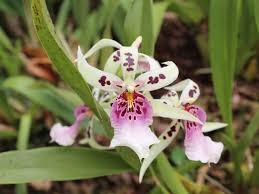### Essential Nutrition and Food for Dendrobium Orchids

Dendrobium orchids are celebrated for their vibrant blooms and stunning varieties, making them a popular choice for both enthusiasts and professional growers. However, to ensure their optimal growth and flowering, it’s crucial to understand their nutritional needs and provide the right food. This article explores the essential nutrition and food requirements for Dendrobium orchids, covering everything from macronutrients to specific fertilization techniques.
### 1. Understanding the Nutritional Needs of Dendrobium Orchids
**1.1. Importance of Nutrition in Orchid Growth**
Nutrition plays a vital role in the growth and health of Dendrobium orchids. Proper nutrients facilitate photosynthesis, root development, flowering, and overall plant vigor. The right balance of nutrients can lead to stronger plants, more abundant blooms, and improved resistance to pests and diseases.
**1.2. Essential Nutrients for Dendrobium Orchids**
Dendrobium orchids require a variety of nutrients, which can be categorized into macronutrients and micronutrients.
– **Macronutrients:** These are nutrients needed in larger quantities and include nitrogen (N), phosphorus (P), and potassium (K). They are often represented in a three-number format on fertilizer packages, such as 30-10-10.
– **Nitrogen (N):** Vital for vegetative growth, nitrogen promotes leaf development and green foliage. It is particularly important during the growing season.
– **Phosphorus (P):** Crucial for root development and flower production, phosphorus supports the overall health of the orchid, especially during the blooming phase.
– **Potassium (K):** Helps in overall plant function, potassium contributes to disease resistance, water regulation, and flowering.
– **Micronutrients:** These are needed in smaller amounts but are equally essential for orchid health. Key micronutrients include magnesium (Mg), calcium (Ca), sulfur (S), and trace elements like iron (Fe), manganese (Mn), zinc (Zn), and copper (Cu).
### 2. Nutrient Sources for Dendrobium Orchids
**2.1. Commercial Fertilizers**
Many commercial fertilizers are formulated specifically for orchids, providing a balanced mix of macronutrients and micronutrients.
– **Balanced Orchid Fertilizers:** These fertilizers often have a N-P-K ratio suitable for all growth stages. For example, a ratio of 30-10-10 can be effective during the growing season to promote lush foliage, while a 15-30-15 mix can support flowering.
– **Slow-Release Fertilizers:** These fertilizers gradually release nutrients over time, providing a consistent supply of nutrients. They can be beneficial for busy growers who may not have the time for frequent fertilization.
**2.2. Organic Fertilizers**
Organic fertilizers are increasingly popular among orchid enthusiasts for their sustainability and lower risk of chemical buildup in the soil.
– **Compost:** Well-aged compost can provide a rich source of nutrients and improve soil structure. It promotes beneficial microorganisms in the root zone, enhancing nutrient uptake.
– **Fish Emulsion:** This organic fertilizer is high in nitrogen and can be used during the growing season to support foliage growth. Dilute it according to package instructions to avoid over-fertilization.
– **Bone Meal:** Rich in phosphorus, bone meal is an excellent organic source to promote root development and flowering.
– **Kelp Meal:** This seaweed-derived fertilizer provides trace minerals and growth hormones, enhancing overall plant health and vigor.
### 3. Fertilization Techniques for Dendrobium Orchids
**3.1. Timing of Fertilization**
The timing of fertilization is crucial for the health of Dendrobium orchids. Understanding their growth cycles can help in applying nutrients at the right time.
– **Growing Season (Spring to Early Summer):** During the active growing season, orchids benefit from regular fertilization. Apply fertilizer every 2-4 weeks, depending on the nutrient concentration.
– **Blooming Season (Late Summer to Fall):** As the orchids begin to flower, switch to a fertilizer higher in phosphorus to support bloom development. Continue fertilizing every 2-4 weeks, but consider reducing the frequency as blooms begin to fade.
– **Resting Period (Late Fall to Winter):** During the resting period, typically in winter, reduce fertilization. The orchids require less energy during this time, and over-fertilizing can lead to nutrient burn.
**3.2. Application Methods**
There are various methods to apply fertilizer to Dendrobium orchids, each with its benefits.
– **Water-Soluble Fertilizers:** These fertilizers can be mixed with water and applied during regular watering. They provide quick nutrient availability, which is essential during active growth phases.
– **Granular Fertilizers:** These fertilizers can be sprinkled on the surface of the potting medium. They release nutrients slowly over time, making them suitable for long-term feeding.
– **Foliar Feeding:** This technique involves spraying diluted fertilizer directly onto the leaves. It allows for quick absorption and is beneficial during periods of rapid growth.
### 4. pH and Nutrient Availability
**4.1. Importance of pH Levels**
The pH level of the potting medium affects nutrient availability for Dendrobium orchids. Most orchids prefer a slightly acidic to neutral pH, typically between 5.5 and 7.0.
– **pH Levels and Nutrient Uptake:** If the pH is too high or too low, certain nutrients may become unavailable. For instance, iron becomes less available in alkaline conditions, leading to chlorosis (yellowing of leaves).
**4.2. Adjusting pH Levels**
If the pH level is outside the preferred range, adjustments can be made.
– **Lowering pH:** Incorporating sulfur or using acidic fertilizers can help lower pH levels.
– **Raising pH:** Lime can be added to raise pH levels, promoting a more alkaline environment.
### 5. Signs of Nutritional Deficiencies
**5.1. Identifying Nutrient Deficiencies**
Understanding the signs of nutrient deficiencies can help growers address issues before they become severe.
– **Nitrogen Deficiency:** Symptoms include yellowing of older leaves, stunted growth, and overall poor health.
– **Phosphorus Deficiency:** This may manifest as dark green or purplish leaves, especially on older growth, and poor flowering.
– **Potassium Deficiency:** Leaves may develop brown edges or tips, and the plant may exhibit weak stems.
– **Micronutrient Deficiencies:** Specific deficiencies, such as iron, can cause yellowing between the veins of young leaves (interveinal chlorosis).
### 6. Common Mistakes in Orchid Nutrition
**6.1. Over-Fertilization**
One of the most common mistakes in orchid care is over-fertilization. This can lead to nutrient burn, where the tips of the leaves turn brown and crispy.
– **Signs of Over-Fertilization:** Symptoms include leaf burn, salt buildup in the potting medium, and poor growth. It’s essential to follow the recommended application rates and adjust based on the orchid’s response.
**6.2. Ignoring Water Quality**
The quality of water used for irrigation can impact nutrient uptake. Tap water with high mineral content or chlorine can affect the plant’s ability to absorb nutrients.
– **Using Clean Water:** Consider using rainwater, distilled water, or filtered water to reduce mineral buildup in the potting medium.
### 7. Conclusion
Understanding the essential nutrition and food requirements for Dendrobium orchids is crucial for successful cultivation. By providing a balanced supply of macronutrients and micronutrients, growers can ensure their orchids thrive, producing stunning blooms and robust foliage. Whether through commercial or organic fertilizers, the key lies in timing and application methods to align with the orchid’s growth cycle.
By monitoring the health of the plants and adjusting fertilization strategies accordingly, growers can cultivate thriving Dendrobium orchids that bring beauty and joy to any environment. Proper nutrition not only enhances the growth and flowering of these exquisite orchids but also promotes resilience against pests and diseases, ensuring a sustainable and vibrant gardening experience. Through careful attention to their nutritional needs, orchid enthusiasts can enjoy the beauty of Dendrobium orchids for years to come.

